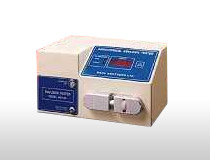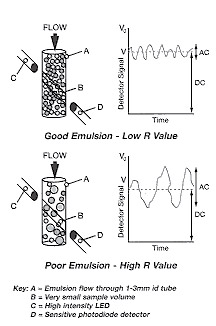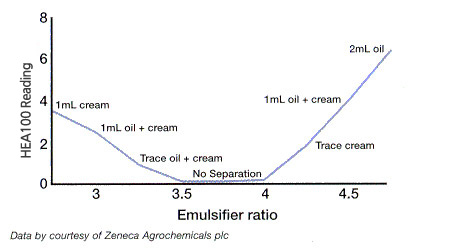High-Resolution Emulsion Analyzer HEA100
 |
The High-Resolution Emulsion
Analyzer HEA100 is designed to test the stability of water-based
agrochemical
emulsions which are widely used in pest control. Easily
surpassing current techniques, the turbidity fluctuation
analysis technique can quickly and precisely characterise
emulsions to bring significant benefits to testing in
the development of new formulations and the quality of
manufactured emulsifiable concentrate products.
- Rapid, objective measurements.
- Extremely simple to operate.
- Highly sensitive to droplet size change.
- Convenient flow-through system.
- Compact and lightweight.
The HEA100 has been developed in collaboration with Zeneca
Agrochemicals and has successfully completed
UK trials involving major manufacturers. |
Testing Emulsions
Good stable emulsions are characterised by very small droplets
and by a fairly narrow distribution of droplet sizes, although
the actual values will
vary between different formulations. These properties should
not change over periods of many hours or even longer.
The HEA100 is designed to detect the size of droplets in oil-water
emulsions using a simple procedure. A prepared emulsion sample
is siphoned through
a capillary sample tube mounted in a flow cell on the front
of the instrument. After 1-2 minutes a reading related to the
stability (R) is displayed:
further tests can be conducted after flushing the sample tube
clean.
Results achieved show good correlation with the traditional
CIPAC test, but with significantly greater sensitivity and taking
only a few minutes.
An optional validation unit is available to confirm the test
performance of the instrument and for compliance with ISO9000
quality assurance procedures.
Operating
Principle
The HEA100 uses an optical system developed at University
College London that responds to the changes
in the size of droplets flowing through the measurement
cell, as indicated in the diagram.
A laser light beam illuminates the flowing emulsion
and the transmitted light is monitored by a sensitive
detector,
which produces a signal comprising two components:
- An average (DC) value related to the turbidity of
the emulsion.
- A smaller, fluctuating (AC) component arising from
random variations in the number and size of the droplets
--in the laser beam.
In unstable emulsions, droplets become larger in size
and smaller in number, which leads to an increase
in the AC component. A measure of the emulsion stability
is derived from the ratio of the AC and
DC components, which is displayed as a reading R. The
higher this reading, the larger the droplets and
the lower the emulsion stability. Conversely, a small
R value indicates a stable emulsion.
|
 |
Applications
The stability of emulsions must be tested to ensure their efficient
use and proper application. A rapid assessment of the emulsion
stability using
The HEA100 will help to prevent breakdown of emulsions and the
formation of oils and creams.
In
developing a formulation
A plot of results using different emulsifier ratios
enable the optimum formulation to be selected.

For routine quality monitoring
Frequent measurements quickly identify potential stability
problems and corrective action can be taken during manufacture.
Technical Data
The HEA100 is supplied with 6 capillary sample tubes, 2mm
silicone tubing, Hoffman clip to adjust flow rate, 250ml beaker
tubing clamp assembly
and a suitable power lead.
- Light source : Laser, 670nm, output 0.95mW.
- Sample flow rate : 10ml/min ±10%.
- Measurement accuracy : ±5%.
- Display: Readings (R) and DC volts.
- Overload indicators: Large particles and turbidity.
- Power supply: 110/120V or 220/240V AC 50/60Hz.
- Size: 320mm (w) x 200mm (d) x 165mm (h).
- Weight: 4.0kg.
Ordering Information
|
Order Code |
Description |
| HEA001A |
High-Resolution Emulsion Analyzer HEA100
& validation unit |
| HEA002A |
High-Resolution Emulsion Analyzer HEA100 |
| HEA003A |
Validation unit for HEA100 |
| HEA170A |
Glass sample tube |
| HEA172A |
Silicone tubing (2 mm bore, 1 mm wall) |
|
